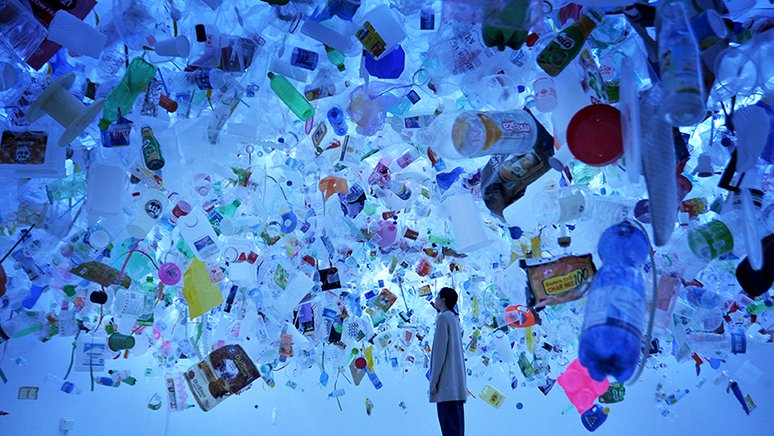While there has been many different artist who have taken on the task of portraying plastic pollution in our world, artist Cod Steaks created a major art instillation that takes the cake in this specific artistic category
. 
Located in Bristol, United Kingdom this piece features two life-sized whales ‘swimming’ in an ocean of plastic soup, made from over 70,00 plastic bottles. This work is supposed to represent the “beauty and fragility of the ocean” and make a clear and bold representation of the reality of the world we have created through constant human environment degradation. The material choice of this work is the most important aspect overall, as the materials themselves are what truly represents the overall agenda of the artist themselves. Focused on the tumultuous amounts of plastic within our ocean, Steaks makes a specific point to shock and involve the audiences attention by displaying a realistic sized model to fully show the impact of the amount of waste and plastic pollution that fills our oceans on a day to day basis.
The grace of the rolling waves and the simplicity and size of the whale only show to contrast the damages and depletion that our Earth is going though due to the human condition and lack of concern our society as a whole as determined. The message is simple and is not an artistic piece that is difficult to understand by any means, but it values the importance of fixing the plastic pollution problem on a global scale
. 
The value of art has a major impact on society as whole, using simple materials and symbolism to capture a message and certain agenda and portray it to the audience. I believe that art is often used as a from of expression over major issues within cultures and societies that need a push to have betterment in their realities. Plastic pollution has become a major issue within our economic, societal, political and cultural standards and has continued to push barriers in debate on what to do to better the environment humans have been depleting for so many years.
While I believe its easy to ‘support’ or ‘understand’ an issue, true symbolism, shock, and influence can not just be easily achieved, and I feel like Steaks does an impeccable job nailing all those major structures. The structure itself is amazing and grand in size that would take an audience by surprise and sheer shock when they stood next to it, yet the true impressiveness is the artistic flow and implicitness of the waves that are made from plastic, the truest form of symbolism of plastic pollution. Every aspect of the piece is made from some sort of plastic or metal material that weaves together the influence plastic has on not only the ocean itself but the marine life it surrounds as well. Cod’s agenda was very specific, with his ideology noting that “our sea of recycled plastic bottles represents the detrimental effect of plastic pollution on the ocean, which is something that all of us can act on—today—by reducing our consumption of single use plastics.” https://www.yahoo.com/entertainment/s/see-whales-swimming-ocean-70-000-plastic-water-212729228.html
Art is a perfect way to symbolize bigger issues with a simple message to capture an audience’s attention and influence them beyond what any research study or article understanding could do. I will always have a major appreciation for the artistic field for the true impressiveness of symbolism and activism weaved within.



 ng rooms alongside many stores throughout Florida.
ng rooms alongside many stores throughout Florida.
















